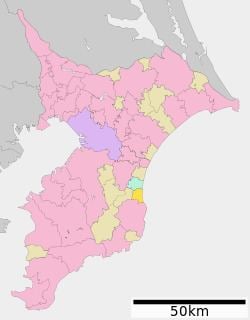District Chōsei Population 12,501 (Nov 2012) | Region Kantō - Tree Japanese black pine Area 23.02 km² Local time Friday 2:00 PM | |
 | ||
Weather 14°C, Wind NW at 14 km/h, 53% Humidity | ||
Ichinomiya (一宮町, Ichinomiya-machi) is a town located in Chōsei District, Chiba Prefecture, Japan. As of 2012, the town had a population of 12,501 and a population density of 543 persons per km². The total area of the town is 23.02 square kilometres (8.89 sq mi).
Contents
- Map of Ichinomiya Chosei District Chiba Prefecture Japan
- Geography
- Neighboring municipalities
- History
- Economy
- Railway
- Highway
- Local attractions
- References
Map of Ichinomiya, Chosei District, Chiba Prefecture, Japan
Geography
Ichinomiya is located on the Pacific coast of central Bōsō Peninsula, encompassing the area of the popular Kujūkuri Beach. The area has a warm maritime climate with hot summers and mild winters.
Ichinomiya is relatively flat compared to the interior of the Bōsō Peninsula. The highest elevations in the town are at Mount Shiroyama 150 metres (490 ft), a former castle site, Mount Takafuji 83 metres (272 ft), and Mount Gundari 70 metres (230 ft).
Neighboring municipalities
History
The area of present-day Ichinomiya has been inhabited since prehistoric times. The area takes its name from the Tamasaki Shrine, the Ichinomiya, or first shrine of Kazusa Province. During the Sengoku period, the Satomi clan, the virtually independent rulers of the Bōsō Peninsula, established a castle at Ichinomiya. During the Edo period, a 13,000 koku feudal domain called Ichinomiya Domain ruled the area. After the start of the Meiji period, the area rapidly developed as a summer health resort, with many noted politicians, military figures, artists and writers establishing summer residences. Ichinomiya Town was created within Chōsei District during the cadastral reform of April 1, 1889.
Economy
The primary industry of Ichinomiya is specialized agriculture, with concentration on tomato, melons and fruits. The tourist and resort industry is also a major component of the local economy.
